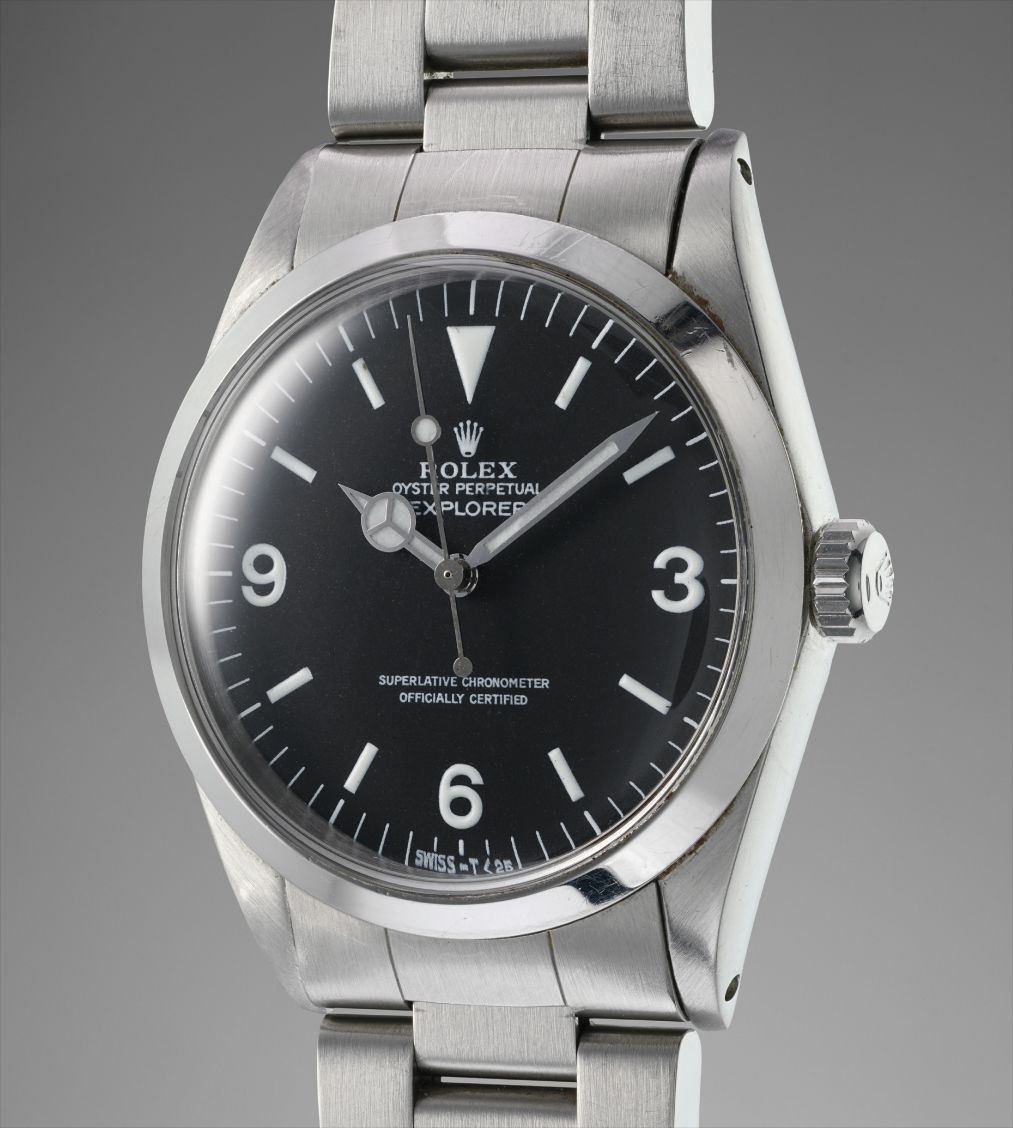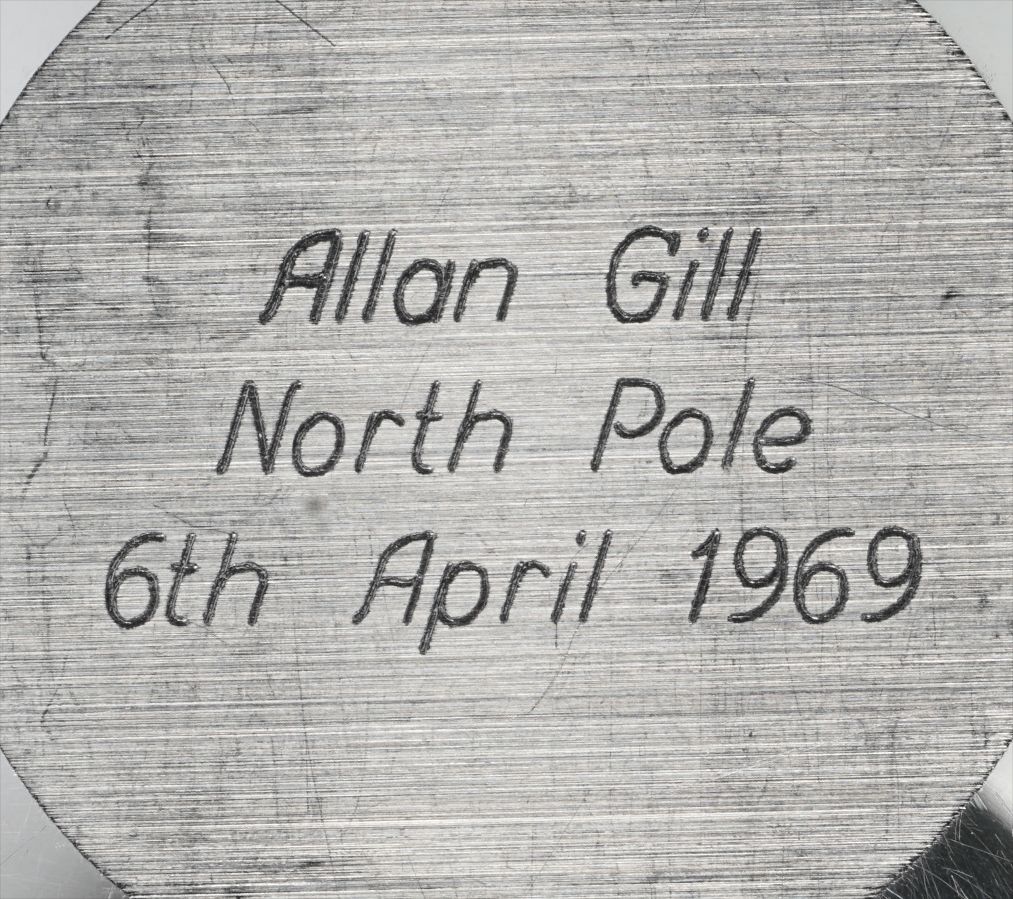







245Ο
Rolex
Ref. 1016
Explorer
An attractive, rare and historically important stainless steel wristwatch with sweep center seconds, 'explorer' dial and bracelet, belonging to both Dr. Colonel Kenneth Hedges and Allan Gill during the 1968/9 Trans-Artic Expedition and used to guide the team to the North Pole
Full-Cataloguing
Yet, the reverse of the watch displays an even more compelling story, one which transcends the present watch beyond an everyday Rolex Explorer. The case back is engraved "Allan Gill North Pole 6th April 1969", referencing the Trans-Arctic Expedition across the "Top of the World".
On the 6 April 1969, the British Trans–Arctic Expedition led by Sir Wally Herbert triumphantly reached Spitzbergen via the North Pole, and was one of the first successful treks of its kind. Sir Wally stated that it was the last treacherous part of man’s exploration of the World, that ‘man had already crossed all the deserts, climbed the highest mountains, made his first conscious probes into the oceans and into space and there is only one pioneer journey left to be made on the surface of the planet.’ (Wally Herbert, July 1967).
His team of Allan Gill, Fritz Koerner, Kenneth Hedges and 34 huskies set out on their 16 month journey from Point Barrow, Alaska to Spitzbergen, via the North Pole and the Pole of Inaccessibility (the farthest point from land in any direction) on the 21st of February 1968. It was the first surface crossing of the Arctic Ocean at its longest axis. The team also conducted important scientific studies throughout, in order to gather data and observations on arctic ice climate which are still pertinent today.
This watch was initially sold by Allan Gill’s sister in 2012. The original ownership of the watch is further underlined by Colonel Kenneth Hedges, the team medic, who confirmed in email correspondence to the new owner that the four members of the team were all issued a Rolex and that he gave this particular watch, initially his watch, to Allan Gill their navigator, as he had lost his own in the snow. It was of course particularly important that Allan Gill had a watch as navigator and Ken Hedges confirms, ‘it was the instrument used to guide us to the North Pole’ and to enable Allan Gill and Kenneth Hedges to first scramble onto the Svalbard archipelago and complete the treacherous and lengthy journey .
Rolex also confirm that whilst they have no records to indicate to whom this watch was originally supplied, they confirm in a letter to Mr Allan Gill’s brother-in-law that Sir Wally Herbert did make use of explorer watches in his British Trans-Arctic Trek in 1968 and ‘furthermore, Sir Wally did ask for the worn case of this particular watch, [serial No] 1376365, to be re-engraved by Rolex in 2005 with the words ‘Allan Gill, North Pole-6th April 1969.’
Allan Gill was an absolutely integral part of the polar exploration team. Not only had he by this point already been awarded the 'United States of America Antarctic medal' for his scientific work in the area and for his ‘ international co-operation in Antarctica’, but a large rounded cliff near the Antarctic shield volcano Mount Tekahe was named Gill Bluff in his honour by the United States. He was also awarded the polar medal and clasps twice, an award shared by the likes of Ranulph Fiennes and Sir Wally Herbert, for his intrepid and important endeavours, in spite of ‘appalling weather and conditions that exist in the Arctic and Antarctic.’ He took part in numerous Polar projects but the four most important were probably the exploration of the drifting iceberg Fletcher’s Island, most famously, the British Trans-Arctic expedition with Sir Wally Herbert, The Arctic Ice dynamics Joint experiment, which possibly paved the way for significant research into climate change, and work on the Fram series of drifting stations near Greenland.
Rolex
Swiss | 1905Founded in 1905 England by Hans Wilsdorf and Alfred Davis as Wilsdorf & Davis, it soon became known as the Rolex Watch Company in 1915, moving its headquarters to Geneva in 1919. Like no other company, the success of the wristwatch can be attributed to many of Rolex's innovations that made them one of the most respected and well-known of all luxury brands. These innovations include their famous "Oyster" case — the world's first water resistant and dustproof watch case, invented in 1926 — and their "Perpetual" — the first reliable self-winding movement for wristwatches launched in 1933. They would form the foundation for Rolex's Datejust and Day-Date, respectively introduced in 1945 and 1956, but also importantly for their sports watches, such as the Explorer, Submariner and GMT-Master launched in the mid-1950s.
One of its most famous models is the Cosmograph Daytona. Launched in 1963, these chronographs are without any doubt amongst the most iconic and coveted of all collectible wristwatches. Other key collectible models include their most complicated vintage watches, including references 8171 and 6062 with triple calendar and moon phase, "Jean Claude Killy" triple date chronograph models and the Submariner, including early "big-crown" models and military-issued variants.